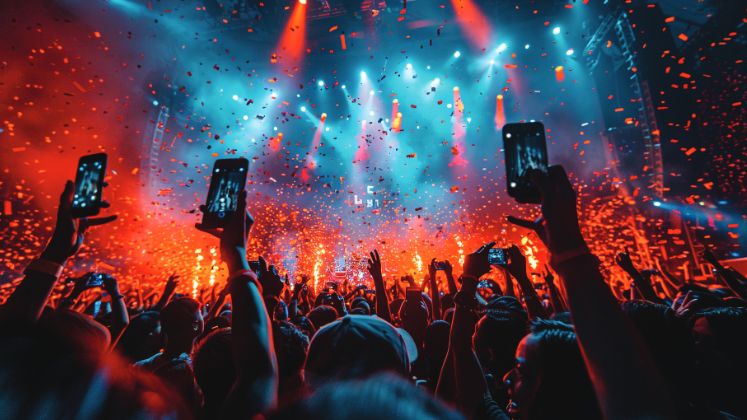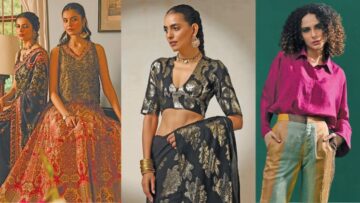The live entertainment sector in India is experiencing rapid growth, projected to reach US $ 35.91 billion by 2026, up from US $ 26.64 billion in 2023. Events’ revenues will contribute to top-line growth, particularly in Tier-2 and Tier-3 markets, where national mass brands need greater connectivity. This expansion is fuelled by young urban Indians seeking real-life connections and experiences amidst digital fatigue and a desire to live life to the fullest. This ‘going-out culture’ fills a void, making immersive festivals and live events crucial ‘third spaces’ for community building. The Fear of Missing Out (FOMO), amplified by social media, further drives the desire to be present at popular events. Notably, upwardly mobile Indians from Tier-2 and Tier-3 cities aspire for the lifestyle these events represent.
For apparel brands, understanding these motivations is key. Here’s how to tap into this trend:
1. Craft Multisensorial Experiences with ‘Feel Appeal’
Apparel brands can move beyond simple sponsorships and create truly immersive experiences. This means designing activations that engage all five senses and create memorable moments that resonate long after the event concludes.
- Day-to-Night Transitions: As ‘nocturnal living’ becomes more prevalent, apparel brands can offer versatile collections that seamlessly transition from day to night events. Imagine pop-up styling stations at festivals offering outfit transformations, or ‘unwind zones’ where attendees can relax and discover comfortable yet stylish apparel options. True Religion, a US-based brand, hosted Buddhafest, an exclusive desert oasis and gifting suite, during Coachella 2024. The event, held at a private venue in Bermuda Dunes, offered guests live DJ sets, custom drinks, treats and a shopping experience with the latest True Religion apparel, including a custom Ford Mustang.
- Emotion-Centric Spaces: Design interactive spaces around core emotions like playfulness or awe, incorporating larger-than-life installations and photo booths that showcase apparel dynamically. Think themed changing rooms or interactive displays where attendees can try on and visualise how different outfits enhance their experience. Nykaaland, India’s largest beauty and lifestyle festival, effectively utilised an Instagrammable Barbie-pink theme with interactive stalls, demonstrating the power of playful engagement. H&M at Coachella integrated its ‘H&M Loves Coachella’ line with an immersive augmented reality experience inside a tent, allowing visitors to virtually try on new clothes and even recycle old ones, aligning fashion with sustainability in a tech-forward way.
- Nostalgia Marketing: Leverage the power of nostalgia, especially for Millennials and Gen X who grew up in pre-Internet India and even overstimulated Gen Z who yearn for a simpler time. Apparel brands can recreate iconic fashion moments from the ’80s and ’90s through themed pop-up shops or limited-edition collections launched at festivals. Magnetic Fields Festival 2024’s nostalgic ‘Confession Booth’ modelled on old Indian telephone booths is a prime example of this.
2. Walk the Talk: Aligning Brand Values with Social Causes
Young Indians prioritise brands that demonstrate authenticity and a commitment to social causes. Apparel brands can build stronger connections by merging entertainment with local culture, community initiatives and eco-accountability.
- Sustainability: With 84% of Gen Z and 90% of Millennials in India actively trying to minimise their environmental impact, sustainability is paramount. Apparel brands can partner with organisations championing sustainable practices, showcasing eco-friendly collections or implementing recycling initiatives at events. Lollapalooza India’s #LollaForChange, with its EV Chalo Bus, reusable cups and waste recycling, sets a precedent for sustainable event practices that apparel brands can emulate or support. Echoes of Earth, India’s ‘greenest music festival’, collaborates with UNEP and WWF, featuring solar-powered stages and upcycled art. Apparel brands can integrate their sustainable fashion lines with such events, perhaps through a ‘zero-waste fashion show’ or by providing uniforms made from recycled materials for event staff.
- Hyperlocal Community Engagement: Connect with influencers and communities in Tier-2 and Tier-3 cities, who feel deeply rooted while also relating to global trends. Apparel brands can fund local cultural initiatives or educational programs, strengthening relationships and showcasing designs that resonate with regional aesthetics and aspirations.
- LGBTQIA+ Inclusivity: The increasing visibility of the LGBTQIA+ community in India presents a significant opportunity. Apparel brands should prioritise inclusivity in their workplace policies and partner with queer influencers and cultural ambassadors. Zomato’s partnership with Gaysi, an LGBTQIA+ media platform, to host a Halloween party for its employees is an excellent example of creating queer-affirming spaces. Apparel brands can create gender-neutral collections or collaborate with LGBTQIA+ designers and artists for event-specific merchandise, fostering a sense of belongingness and celebrating diversity.
Measuring the Impact of Campaigns
|
3. Research Subcultures for Unexpected Partnerships
Apparel brands should invest in youth culture experts and constantly monitor underground trends to identify unexpected partnership opportunities.
- Youth-Centric Collaborations: With Gen Z driving an estimated 43% of consumer spending in India, accounting for US $ 860 billion, understanding their trends is vital. Partnerships with events like the Under 25 Summit can help apparel brands gain trust and engagement. This could involve sponsoring emerging artists’ wardrobes for performances or hosting design competitions for young talent at such summits. H&M exemplified this by collaborating with Lollapalooza India, offering shoppers passes to the festival, demonstrating a direct bridge between apparel retail and youth music culture to merge consumer bases and boost brand visibility.
- Travel and Sports Tourism: With 46% of Indian Gen Z inspired to travel overseas for events and India being amongst the top five Asian countries for Paris Olympics flight bookings, there’s a clear link to travel. Brands can create travel-friendly collections or co-brand with ride-sharing apps or hotel chains, offering exclusive deals and themed merchandise for young Indian travellers attending major events. Royal Enfield, for instance, tapped into India’s biking culture with its #UncoverNorthEast tour, showcasing limited-edition gear. Brands can create ‘adventure wear’ lines that resonate with such niche travel subcultures.
- Artist and Tour Collaborations: Directly partnering with musicians and their tours offers immense potential for apparel brands. Levi’s partnered with the popular Indian artist, Diljit Dosanjh, for his ‘Dil-luminati’ tour, launching exclusive limited-edition T-shirts, hoodies and sweatshirts. This collaboration showcased how merchandise tie-ups can drive resonance and sales. Similarly, United Colors of Benetton became the official styling partner for Bryan Adams’ India tour, aligning their brand with a global music icon to build an aspirational image and boost retail sales.
- Culturally Significant Event Integration: Apparel brands can also integrate into large-scale cultural events to elevate their brand presence. For instance, Michael Kors strategically leveraged the Lifestyle Asia India Diwali Bash. While not a music festival, this event demonstrated how a luxury apparel brand can deeply integrate into a significant cultural celebration, generating extensive media coverage and influencer engagement, thereby solidifying its footprint in the Indian luxury market.
BY WGSN
For Query reach out: Puneet Dudeja, puneet.dudeja@wgsn.com







